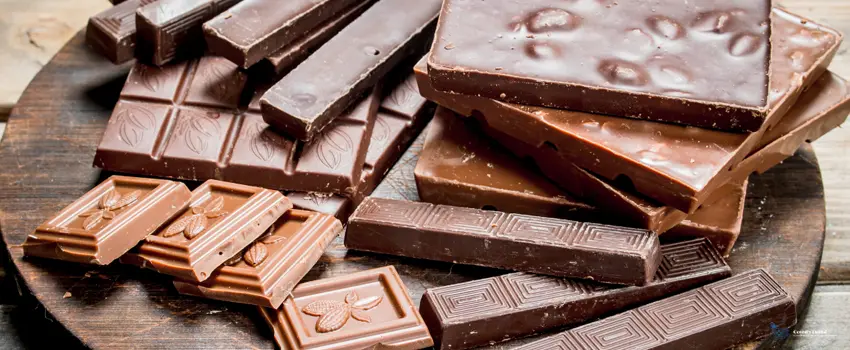With Valentine’s Day around the corner, love is in the air, and chocolates are bound to pour in. While chocolate is an all-around treat, this sweet indulgence has a complex relationship with oral health.
Chocolate is both a treat and a threat. It has antioxidants that are beneficial for our oral health. But, they also have a high sugar content and can stain and harm our teeth.
So, do we hate chocolate, or do we love it? Let’s explore the benefits and drawbacks of chocolate for oral health and learn tips on balancing our love for chocolate with oral hygiene.
Is there such a thing as good chocolate?
Chocolate is often portrayed as bad for our teeth, but there is such a thing as good chocolate. Good news for chocolate lovers out there!
Many experts consider dark chocolate good chocolate because of its high cacao percentage (usually over 70%) and low sugar content. Studies show it’s also rich in antioxidants that positively impact oral health.
On the other end of the spectrum is milk chocolate. It’s considered bad chocolate because of its high sugar content. Their artificial sweeteners and added sugars harm oral health, contributing to tooth decay, cavities, and staining.
The Benefits of Chocolate for Oral Health
Chocolate is not often as unhealthy as it’s painted to be. Consuming it in moderation offers many health benefits, which include the following:
Good chocolate can help reduce cavities.
Xylitol is a non-sugar sweeter often found in sugar-free products like gum. Many experts see it as a teeth-friendly sugar alternative, bringing all the sweetness without the harm sugar causes.
A study has shown that xylitol-sweetened chocolate can help reduce the incidence of cavities. However, they need to be free of acidic flavorings. Further study is necessary.
Good chocolate reduces harmful oral bacteria.
Bad bacteria grows out of control when sugar is around and you don’t practice good oral hygiene. Most bad chocolates are sweet and full of sugar, which nourishes the bad bacteria that causes many oral health problems.
However, studies have shown that the compounds found in good chocolate can help reduce the growth of harmful oral bacteria, such as Streptococcus mutans, that contribute to tooth decay and cavities.
The results of a study published in the Journal of Agricultural and Food Chemistry showed that dark chocolate’s polyphenols reduce the growth of harmful oral bacteria, helping to prevent gum disease and other oral health problems.
Good chocolate contains antioxidants.
Dark chocolate is rich in antioxidants, like polyphenols, that protect our teeth and gums from free radical damage. And according to a 2009 study published in the Journal of Periodontology, they also have anti-inflammatory properties that help reduce the risk of gum disease.
While these benefits can’t outweigh the negative effects of chocolate, they do show that eating chocolate in moderation positively impacts our oral health. They also depend on the type and amount of chocolate we consume.
The Drawbacks of Chocolate for Oral Health
While chocolate can have some benefits for oral health, knowing its potential drawbacks is also crucial. Here are some of the ways chocolate negatively impacts our oral health:
Chocolate’s high sugar content leads to tooth decay and cavities.
High sugar content is one of chocolate’s main drawbacks, contributing to tooth decay and cavities. It feeds the harmful bacteria in our mouths, increasing plaque and tartar buildup. They can cause gum disease and tooth decay, which can also cause tooth pain and sensitivity. In severe cases, they may also require a filling or extraction.
A 2016 study on plaque retention from eating different chocolate types found that chocolate consumption decreases plaque pH 20 minutes after consumption and that caramel chocolate results in more chocolate left on the teeth.
Chocolate can stain teeth.
Chocolate, especially dark chocolate, can stain teeth due to its high chromogen content. They are pigments that can penetrate and discolor enamel. They turn teeth yellow or brown, making them appear less white and healthy.
Finding the Right Balance
Don’t worry too much about chocolate. You can still enjoy this decadent treat while also maintaining good dental hygiene. Aside from visiting your dentist for preventive care, here are some tips on how to balance your love for chocolate and oral health:
Choose dark chocolate.
As discussed earlier, dark chocolate is good chocolate. It has the highest percentage of cacao over powdered milk and sugar, making it better than most chocolate types for oral health. It’s also rich in antioxidants and less sugar content, helping reduce the negative impact of chocolate on your teeth and gums.
Limit chocolate portion size and frequency of consumption.
Eating the right chocolate in moderation helps minimize its harmful effect on oral health. Try reducing your portion sizes and limiting your consumption to a few times a week.
Chocolate consumption is not the only thing you should limit; you should also reduce the sugary drinks and snacks you consume. It helps reduce the amount of sugar in your diet and the risk of tooth decay and cavities.
Practice proper oral hygiene.
Maintaining oral hygiene practices like regular brushing and flossing helps counteract the negative effects of chocolate. You should also use mouthwash to kill bacteria and freshen your breath. Lastly, it’s best that you visit your dentist regularly to ensure that your teeth and gums are taken care of.
Following these tips can help you enjoy chocolate while also taking care of your oral health. Always remember: moderation is key. It’s essential to find the right balance between enjoying your favorite treats and taking care of your teeth and gums.
Key Takeaway
The relationship between chocolate and oral health is complex. Chocolate can benefit oral health but it can also negatively impact your teeth and gums.
To balance your love-hate relationship between chocolate and oral health, choose dark chocolate with at least 70% cacao and limit your portion size and frequency of consumption. Additionally, practicing good oral hygiene, such as regular brushing and flossing, and avoiding sugary snacks and drinks can help maintain good oral health.
With care and moderation, it is possible to enjoy chocolate while still taking care of your teeth and gums. Whether for Valentine’s Day or any other day, treat yourself to a piece of dark chocolate and enjoy the benefits it offers, while also taking care of your oral health.
Give your teeth some TLC.
Valentine’s Day will be a day filled with romance and love. Prepare for it by giving your teeth some TLC at Century Dental. Our nearby South Pasadena dentist provides cosmetic dentistry services such as teeth whitening and veneers that can help improve your smile and appearance and boost your confidence.
Book an appointment with us today.









